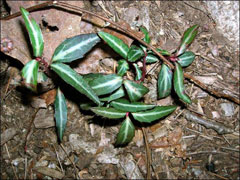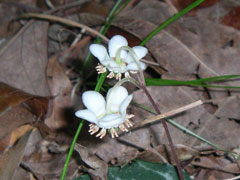 |
|
http://commons.wikimedia.org/wiki/User:TheAlphaWolf |
 |
| http://commons.wikimedia.org/wiki/User:Penarc |
Translate this page:
Summary
Bloom Color: White.
Main Bloom Time: Early summer, Late spring. Form: Prostrate.
Physical Characteristics

 Chimaphila maculata is an evergreen Shrub growing to 0.3 m (1ft) by 0.5 m (1ft 8in) at a slow rate.
Chimaphila maculata is an evergreen Shrub growing to 0.3 m (1ft) by 0.5 m (1ft 8in) at a slow rate.
See above for USDA hardiness. It is hardy to UK zone 6. It is in leaf all year, in flower from June to August. The species is hermaphrodite (has both male and female organs).
Suitable for: light (sandy), medium (loamy) and heavy (clay) soils. Suitable pH: mildly acid, neutral and basic (mildly alkaline) soils. It can grow in semi-shade (light woodland) or no shade. It prefers moist soil.
UK Hardiness Map
US Hardiness Map
Synonyms
Plant Habitats
Woodland Garden Dappled Shade; Shady Edge; Ground Cover;
Edible Uses
Edible Parts: Leaves
Edible Uses: Tea
The leaves are used as a snack, being nibbled for their refreshing qualities[183, 257]. In Mexico the herb is used as a catalyst in the preparation of 'tesguino', an alcoholic beverage produced from sprouted maize[183].
References More on Edible Uses
Medicinal Uses
Plants For A Future can not take any responsibility for any adverse effects from the use of plants. Always seek advice from a professional before using a plant medicinally.
Analgesic Antibacterial Antiscrophulatic Astringent Cancer Diaphoretic Diuretic Febrifuge
Rubefacient Skin Stimulant Tonic Urinary
The plant is analgesic, antibacterial, astringent, diaphoretic, diuretic, febrifuge, rubefacient, stimulant and tonic[4, 207, 222, 257]. The plant has an antiseptic influence on the urinary system and is sometimes used in the treatment of cystitis[4]. An infusion of the plant has been drunk in the treatment of rheumatism and colds[257]. A poultice of the root has been used to treat pain[257] whilst the plant has also been used as a wash on ulcers, scrofula and cancers[257]. All parts of the plant can be used, though only the leaves are officinal[4]. The plant is loaded with the biologically active compounds arbutin, sitosterol and ursolic acid[222]. Arbutin hydrolyzes to the toxic urinary antiseptic hydroquinone[222].
References More on Medicinal Uses
The Bookshop: Edible Plant Books
Our Latest books on Perennial Plants For Food Forests and Permaculture Gardens in paperback or digital formats.

Edible Tropical Plants
Food Forest Plants for Hotter Conditions: 250+ Plants For Tropical Food Forests & Permaculture Gardens.
More

Edible Temperate Plants
Plants for Your Food Forest: 500 Plants for Temperate Food Forests & Permaculture Gardens.
More

More Books
PFAF have eight books available in paperback and digital formats. Browse the shop for more information.
Shop Now
Other Uses
The plants stoloniferous root system, and dwarf spreading habit make it a god ground cover, though it is a difficult plant to establish and grow well[245].
Special Uses
Food Forest Ground cover Scented Plants
References More on Other Uses
Cultivation details
Landscape Uses:Ground cover, Woodland garden. Requires a light moist but well-drained lime-free soil and shade from direct sunlight[1]. This species is difficult to propagate and grow in cultivation, mainly because it has certain mycorrhizal associations in the wild and these are necessary if the plant is to thrive[200]. It is best to use some soil collected from around an established plant when sowing seed or planting out into a new position[200]. The plant has wide-spreading fibrous feeding roots and will often die or fail to increase in size if these are disturbed. The flowers are deliciously scented[245]. Special Features:
North American native. The plant is heat tolerant in zones 8 through 5. (Plant Hardiness Zones show how well plants withstand cold winter temperatures.
Plant Heat Zones show when plants would start suffering from the heat.
The Plant Heat Zone map is based on the number of "heat days" experienced in a given area where the temperature climbs to over 86 degrees F (30°C).
At this temperature, many plants begin to suffer physiological damage. Heat Zones range from 1 (no heat days) to 12 (210 or more heat days).
For example Heat Zone. 11-1 indicates that the plant is heat tolerant in zones 11 through 1.) For polyculture design as well as the above-ground architecture (form - tree, shrub etc. and size shown above) information on the habit and root pattern is also useful and given here if available. An evergreen. The plant growth habit is a runner spreading indefinitely by rhizomes or stolons [1-2]. The root pattern is rhizomatous with underground stems sending roots and shoots along their length [1-2].
References Carbon Farming Information and Carbon Sequestration Information
Temperature Converter
Type a value in the Celsius field to convert the value to Fahrenheit:
Fahrenheit:
The PFAF Bookshop
Plants For A Future have a number of books available in paperback and digital form. Book titles include Edible Plants, Edible Perennials, Edible Trees,Edible Shrubs, Woodland Gardening, and Temperate Food Forest Plants. Our new book is Food Forest Plants For Hotter Conditions (Tropical and Sub-Tropical).
Shop Now
Plant Propagation
Seed - very difficult to germinate, see the notes in cultivation details. It is best sown on moist sphagnum peat. As soon as they are large enough to handle, prick the seedlings out into individual pots and grow them on in a shady position in the greenhouse for at least their first winter. Plant them out into their permanent positions in late spring or early summer, after the last expected frosts. Division. Rather difficult because the plant is very sensitive to root disturbance. It is best attempted in the spring as the plant comes into growth[200]. Cuttings of softwood, June in a frame. Use some soil from around an established plant[14].
Other Names
If available other names are mentioned here
Native Range
NORTHERN AMERICA: Canada, Ontario, United States, Connecticut, Indiana, Maine, Massachusetts, Michigan, New Hampshire, New Jersey, Ohio, Pennsylvania, Rhode Island, Vermont, West Virginia, Illinois, Alabama, Florida (Leon Co.), Georgia, Kentucky, Maryland, North Carolina, South Carolina, Tennessee, Virginia, Mexico, Chihuahua, Coahuila de Zaragoza, Durango, San Luis Potosí, Sinaloa, Sonora, Tamaulipas, Zacatecas, Chiapas, Colima, Guanajuato, Guerrero, Hidalgo, Jalisco, México, Morelos, Nayarit, Oaxaca, Puebla, Querétaro, Veracruz de Ignacio de la Llave, SOUTHERN AMERICA: Costa Rica, Guatemala, Honduras, Nicaragua, Panama,
Weed Potential
Right plant wrong place. We are currently updating this section.
Please note that a plant may be invasive in one area but may not in your area so it's worth checking.
Conservation Status
IUCN Red List of Threatened Plants Status :

Growth: S = slow M = medium F = fast. Soil: L = light (sandy) M = medium H = heavy (clay). pH: A = acid N = neutral B = basic (alkaline). Shade: F = full shade S = semi-shade N = no shade. Moisture: D = dry M = Moist We = wet Wa = water.
Now available:
Food Forest Plants for Mediterranean Conditions
350+ Perennial Plants For Mediterranean and Drier Food Forests and Permaculture Gardens.
[Paperback and eBook]
This is the third in Plants For A Future's series of plant guides for food forests tailored to
specific climate zones. Following volumes on temperate and tropical ecosystems, this book focuses
on species suited to Mediterranean conditions—regions with hot, dry summers and cool, wet winters,
often facing the added challenge of climate change.
Read More
Expert comment
Author
(L.)Pursh.
Botanical References
200204235
Links / References
For a list of references used on this page please go here
Readers comment
© 2010, Plants For A Future. Plants For A Future is a charitable company limited by guarantee, registered in England and Wales. Charity No. 1057719, Company No. 3204567.